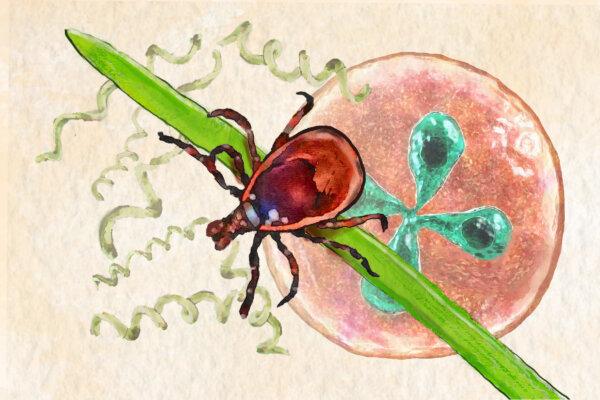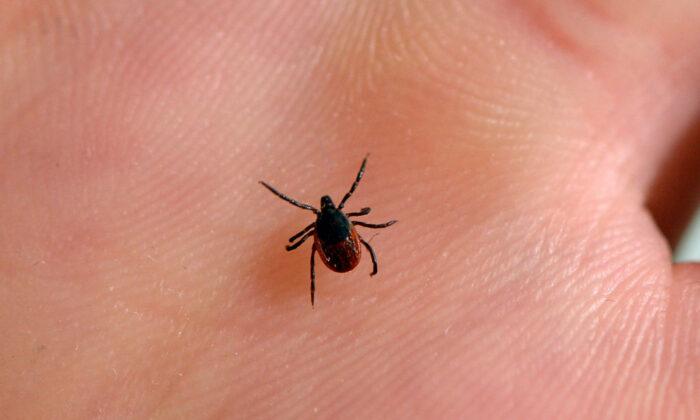The season of creepy-crawlies has arrived in Canada, but there is one particular insect that can be especially dangerous: ticks.
Ticks can carry bacterial illnesses, infections, or various types of fevers, making the tiny parasitic arachnids a danger to both you and your pets.
While there are more than 40 tick species in Canada, it’s the blacklegged tick and the Western blacklegged tick that are most commonly associated with Lyme disease, a potentially serious bacterial sickness.
University of Guelph staff scientist Justin Wood told The Epoch Times the blacklegged tick is prevalent from Manitoba to Nova Scotia, while the Western blacklegged tick is more prevalent on the West coast, from Vancouver island to the coastal mainland.
“Other species of ticks exist across Canada, but these are the two most medically relevant species as they are the main vectors for Lyme disease, tick-borne relapsing fever, anaplasmosis, babesiosis and more,” says Mr. Wood, who is also CEO of Geneticks, Canada’s first private tick testing company. “In Ontario, approximately 25 percent of blacklegged ticks carry some sort of human pathogen.”
Ticks need blood from humans or animals to survive. The minuscule parasites attach themselves to their host by burrowing their heads into the skin where they can feed on the blood of their victims until engorged.
It is during this feeding period that infection can occur, the government website says. If the tick is removed soon enough, however, the chance of illness is drastically reduced.
“Removing attached ticks as soon as possible reduces the chance of infection,” the agency says. “Infected blacklegged ticks need to be attached for at least 24 hours in order to transmit the bacteria that causes Lyme disease.”
The growing tick population has translated into an increase in Lyme disease, however. In 2009, there were just 144 cases compared to 2023 when more than 2,540 cases of Lyme disease were reported, government stats show.

How to Avoid Ticks
Due to their size, ticks can be difficult to detect, especially before they reach adult size. An adult is approximately the size of a sesame seed, while young ticks, also known as nymphs, can be as tiny as a poppy seed.While ticks are more common in wooded areas and fields with long grass, they can also be found in suburban and urban environments, Mr. Wood says.
“Anywhere that birds and mammals go, you can find ticks,” he said.
While avoiding tick habitats is your best bet for preventing bites, it is not alway realistic.
“If you are going into tick habitats, I would recommend wearing light coloured clothing that covers as much skin as possible, using insect repellents that contain icaridin or picaridin, and doing frequent tick checks during and after your time in a tick environment,” Mr. Wood says.
Placing clothing in the dryer on high for 10 to 15 minutes after being outdoors can also help kill any ticks that have found their way into your clothes, he adds.
Another option is to wear permethrin-treated clothing—clothing that has been treated with the insecticide by a manufacturer to protect against mosquitoes and ticks.
Performing daily full body checks on yourself, your children, and pets after coming in from the outdoors and showering or bathing within two hours of being in forested or long grass areas will help ensure you and your household is tick-free, the health agency suggests.
How to Deal With a Tick Bite
Finding a tick burrowed in your skin can be scary, but staying calm is essential to ensure you remove the tick properly, Mr. Wood says.The best way to remove the tick is with a pair of fine-tipped tweezers. Grasp the tick as close to the skin as possible and pull the tick firmly up and out of the skin. Once the tick is removed, it can be stored for identification purposes.

What Diseases Can Ticks Carry?
There are many types of tick-borne diseases, but Lyme disease is the most common in Canada. Other possible diseases include anaplasmosis, babesiosis, ehrlichiosis, and Powassan virus.Fever, chills, headache, muscle aches and pains, and nausea or vomiting are some of the most common symptoms of the tick-borne diseases, according to the government website.
Lyme disease can also come with an expanding rash, swollen lymph nodes, muscle pain, numbness or tingling, and even more serious consequences such as arthritis, facial paralysis, abnormal heartbeat, memory loss, and swelling of the brain and spinal cord.
“Early diagnosis and treatment of Lyme disease can prevent complications,” the site says. “Consult your health care provider right away if you’ve been bitten by a tick and develop symptoms of Lyme disease.”
Antibiotics is the only way to treat Lyme disease, the agency says, and the earlier you receive treatment, the better your chance is for a successful recovery.







